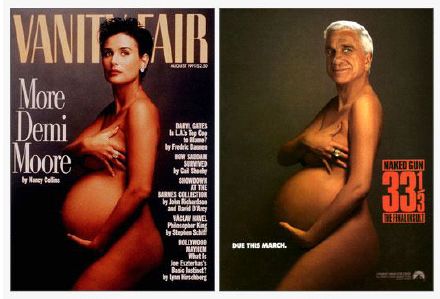I joined with many last week who were thrilled to hear that a collection of iconic photos by celebrity photographer Annie Leibovitz has landed a permanent home at the Art Gallery of Nova Scotia. Apart from their artistic merit, one photo which we will soon see up close has found its way into copyright casebooks.
In 1991, actress Demi Moore was photographed by Leibovitz naked and seven months pregnant for the cover of Vanity Fair magazine. It became one of the highest selling issues in the history of Vanity Fair and generated significant controversy. Two years later, as part of the Naked Gun movie series, Paramount Pictures launched a national ad campaign for "Naked Gun 33 1/3: The Final Insult." Leslie Neilsen's smug mug was superimposed on the body of a naked and pregnant woman (not Demi Moore's) with the caption "Due this March". The pose, background and lighting were set up to closely resemble the original Leibovitz photo of Moore.

Leibovitz sued for copyright infringement.
The U.S. Court of Appeals for the Second Circuit affirmed the decision of the Southern District of New York that it was "fair use" ( Leibovitz v. Paramount Pictures Corp). Although Paramount's photographer drew heavily from Leibovitz' composition, the ad was recognizable as parody. Elements of the composition led to this conclusion - the lighting was more garish, the ring on the model was larger and flashier and Neilson was smirking compared to the serene and serious Moore. And the bottom line - he's a pregnant man!! Finally, although the ad was used by Paramount for a commercial purpose, there was admittedly, no market harm to Leibovitz. The court was undeterred by the argument that celebrities would be reluctant to pose if they risked being parodied, finding this was not a recognizable harm.
Until November 2012, it would have been doubtful if a Canadian court could (or would) have reached the same conclusion. But, as we have written about previously, Canada has recently passed amendments to the Copyright Act such that "fair dealing for the purpose of research, private study, education, parody or satire does not infringe copyright." ( Parody & Satire into Canada's Copyright Act: A Birth or merely a Confirmation?)
Of course, recognizing a use as parody isn't enough; a court will still asses the "fairness" of the use by assessing six factors: the purpose, character, and amount of the dealing; the existence of any alternatives to the dealing; the nature of the work; and the effect of the dealing on the work.
To date, there are no reported Canadian cases adjudicating on the new parody rights in the Copyright Act and it remains to be seen how a court will approach these new rights. Until then, when you're visiting the AGNS, stop and admire Ms. Leibovitz's photos, but think twice before you parody them.
The content of this article is intended to provide a general guide to the subject matter. Specialist advice should be sought about your specific circumstances.
We operate a free-to-view policy, asking only that you register in order to read all of our content. Please login or register to view the rest of this article.


